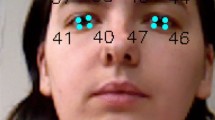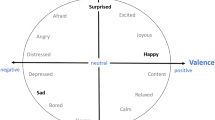Abstract
The current preliminary study concerns the identification of the effects human-humanoid interaction can have on human emotional states and behaviors, through a physical interaction. Thus, we have used three cases where people face three different types of physical interaction with a neutral person, Nadine social robot and the person on which Nadine was modelled, Professor Nadia Thalmann. To support our research, we have used EEG recordings to capture the physiological signals derived from the brain during each interaction, audio recordings to compare speech features and a questionnaire to provide psychometric data that can complement the above. Our results mainly showed the existence of frontal theta oscillations while interacting with the humanoid that probably shows the higher cognitive effort of the participants, as well as differences in the occipital area of the brain and thus, the visual attention mechanisms. The level of concentration and motivation of participants while interacting with the robot were higher indicating also higher amount of interest. The outcome of this experiment can broaden the field of human-robot interaction, leading to more efficient, meaningful and natural human-robot interaction.
Access this chapter
Tax calculation will be finalised at checkout
Purchases are for personal use only
Similar content being viewed by others
References
Ekman, P.: Darwin and Facial Expressions. Academic Press, New York (1973)
Wang, Y., Quadflieg, S.: In our own image? Emotional and neural processing differences when observing human-human vs human-robot interactions. Soc. Cogn. Affect. Neurosci. 10(11), 1515–1524 (2014). https://doi.org/10.1093/scan/nsv043
Perez-Gaspar, L.A., Caballero-Morales, S.O., Trujillo-Romero, F.: Multimodal emotion recognition with evolutionary computation for human-robot interaction. Expert Syst. Appl. 66, 42–61 (2016). https://doi.org/10.1016/j.eswa.2016.08.047
Urgen, B.A., Plank, M., Ishiguro, H., Poizner, H., Saygin, A.P.: EEG theta and Mu oscillations during perception of human and robot actions. Front. Neurorobot. 7, 1–13 (2013)
Esposito, A., Esposito, A.M., Vogel, C.: Needs and challenges in human computer interaction for processing social emotional information. Pattern Recogn. Lett. 66, 41–51 (2015)
Nakisa, B., Rastgoo, M.N., Tjondronegoro, D., Chandran, V.: Evolutionary computation algorithms for feature selection of EEG-based emotion recognition using mobile sensors. Expert Syst. Appl. 93, 143–155 (2018). https://doi.org/10.1016/j.eswa.2017.09.062
Poria, S., Cambria, E., Hussain, A., Huang, G.B.: Towards an intelligent framework for multimodal affective data analysis. Neural Netw. 63, 104–116 (2015)
Zheng, W.-L., Dong, B.-N., Lu, B.-L.: Multimodal emotion recognition using EEG and eye tracking data. In: 2014 36th Annual International Conference of the IEEE Engineering in Medicine and Biology Society, pp. 5040–5043 (2014). https://doi.org/10.1109/EMBC.2014.6944757
Jatupaiboon, N., Pan-Ngum, S., Israsena, P.: Emotion classification using minimal EEG channels and frequency bands. In: 2013 10th International Joint Conference on Computer Science and Software Engineering (JCSSE), pp. 21–24 (2013). https://doi.org/10.1109/JCSSE.2013.6567313
Wan Ismail, W.O.A.S., Hanif, M., Mohamed, S.B., Hamzah, N., Rizman, Z.I.: Human emotion detection via brain waves study by using electroencephalogram (EEG). Int. J. Adv. Sci. Eng. Inf. Technol. 6(6), 1005 (2016)
Jenke, R., Peer, A., Buss, M.: Feature extraction and selection for emotion recognition from EEG. IEEE Trans. Affect. Comput. 5(3), 327–339 (2014)
Thammasan, N., Moriyama, K., Fukui, K., Numao, M.: Familiarity effects in EEG-based emotion recognition. Brain Inform. 4(1), 39–50 (2017). https://doi.org/10.1007/s40708-016-0051-5
de Borst, A., de Gelder, B.: Is it the real deal? Perception of virtual characters versus humans: an affective cognitive neuroscience perspective. Front. Psychol. 6, 576 (2015)
Cheetham, M., Pavlovic, I., Jordan, N., Suter, P., Jancke, L.: Category processing and the human likeness dimension of the uncanny valley hypothesis: eye tracking data. Front. Psychol. 4, 108 (2013)
Cheetham, M., Suter, P., Jäncke, L.: The human likeness dimension of the uncanny valley hypothesis: behavioral and functional MFR findings. Front. Hum. Neurosci. 5, 126 (2011)
Moser, E., Derntl, B., Robinson, S., et al.: Amygdala activation at 3T in response to human and avatar facial expressions of emotions. J. Neurosci. Methods 161, 126–133 (2007)
Chaminade, T., Cheng, G.: Social cognitive neuroscience and humanoid robotics. J. Physiol. 103, 286–295 (2009)
Breazeal, C.: Emotion and sociable humanoid robots. Int. J. Hum. Comput. Interact. 59, 119–155 (2003)
Lisetti, C.L., Nasoz, F., Lerouge, C., Ozyer, O., Alvarez, K.: Developing multimodal intelligent affective interfaces for tele-home health care. Int. J. Hum.-Comput. Stud. Spec. Issue Appl. Affect. Comput. HCI 59(1–2), 245–255 (2003)
Babiloni, C., Del Percio, C., Vecchio, F., et al.: Alpha, beta and gamma electrocorticographic rhythms in somatosensory, motor, premotor and prefrontal cortical areas differ in movement execution and observation in humans. Clin. Neurophysiol. 127(1), 641–654 (2016)
Cavanagh, J.F., Frank, M.J.: Frontal theta as a mechanism of cognitive control. Trends Cogn. Sci. 18(8), 414–421 (2014)
Baka, E., Stavroulia, K.E., Magnenat-Thalmann, N., Lanitis, A.: An EEG-based evaluation for comparing the sense of presence between virtual and physical environments. In: Proceedings of Computer Graphics International (CGI 2018), 10 p. ACM, New York (2018)
Acknowledgments
This research is partly supported by the BeingTogether Centre, a collaboration between Nanyang Technological University (NTU) Singapore and University of North Carolina (UNC) at Chapel Hill. The BeingTogether Centre is supported by the National Research Foundation, Prime Ministers Office, Singapore under its International Research Centers in Singapore Funding Initiative. This research is partly supported by the European Commission through the project MINGEI.
Author information
Authors and Affiliations
Corresponding author
Editor information
Editors and Affiliations
Rights and permissions
Copyright information
© 2019 Springer Nature Switzerland AG
About this paper
Cite this paper
Baka, E., Vishwanath, A., Mishra, N., Vleioras, G., Thalmann, N.M. (2019). “Am I Talking to a Human or a Robot?”: A Preliminary Study of Human’s Perception in Human-Humanoid Interaction and Its Effects in Cognitive and Emotional States. In: Gavrilova, M., Chang, J., Thalmann, N., Hitzer, E., Ishikawa, H. (eds) Advances in Computer Graphics. CGI 2019. Lecture Notes in Computer Science(), vol 11542. Springer, Cham. https://doi.org/10.1007/978-3-030-22514-8_20
Download citation
DOI: https://doi.org/10.1007/978-3-030-22514-8_20
Published:
Publisher Name: Springer, Cham
Print ISBN: 978-3-030-22513-1
Online ISBN: 978-3-030-22514-8
eBook Packages: Computer ScienceComputer Science (R0)




